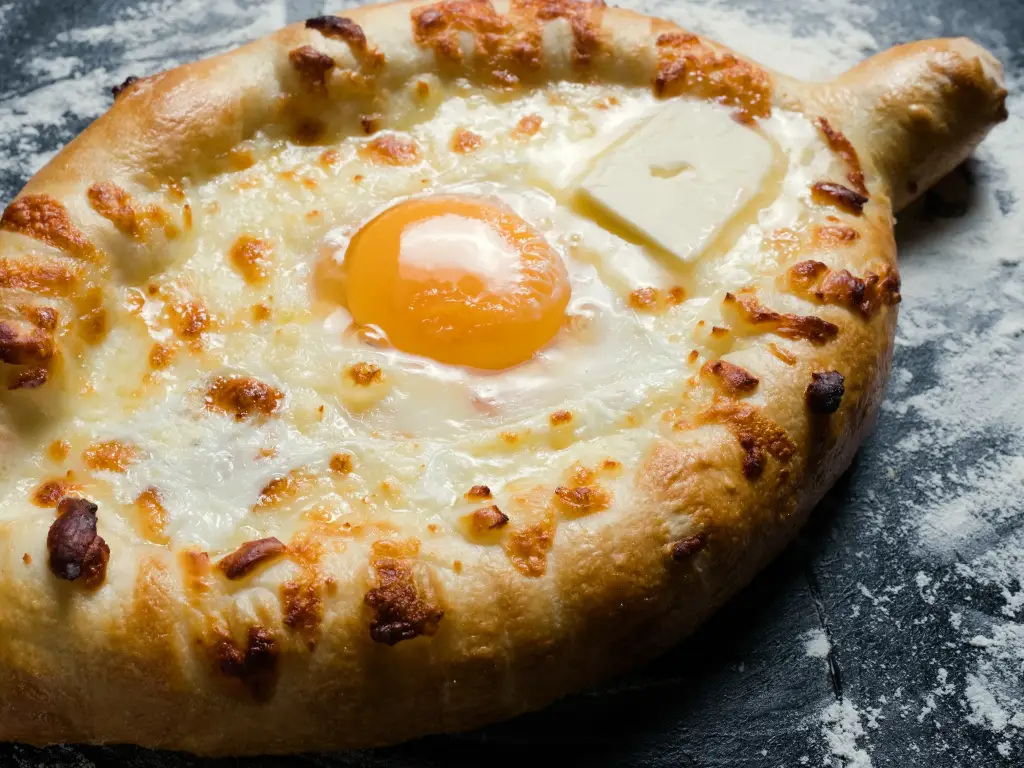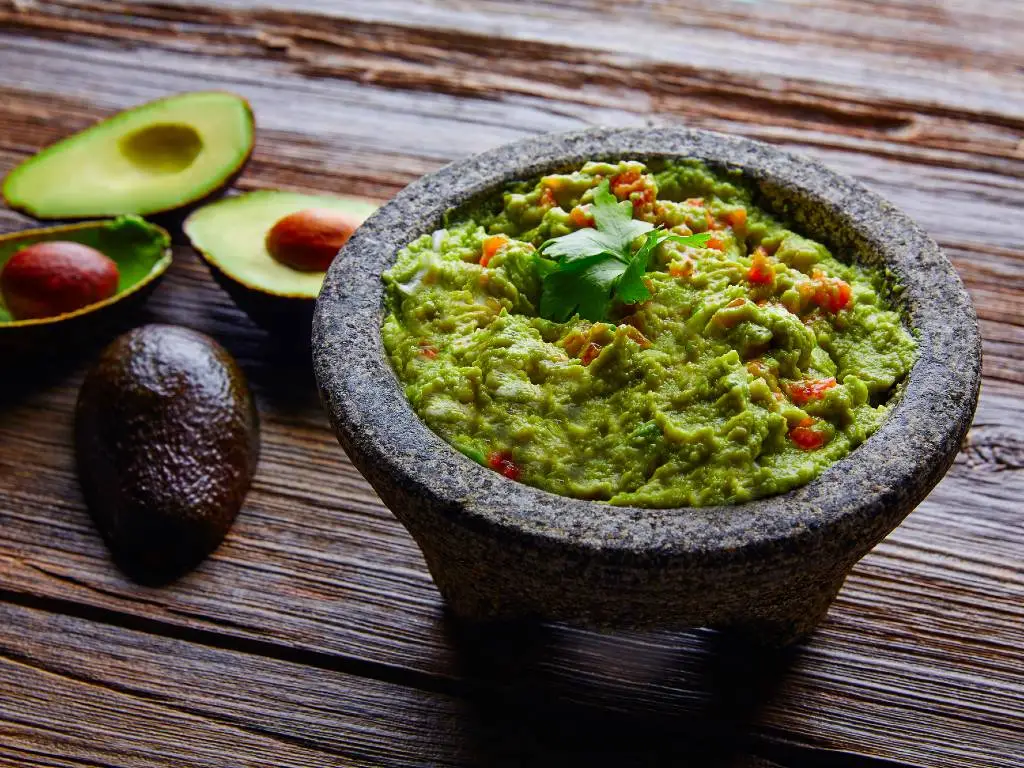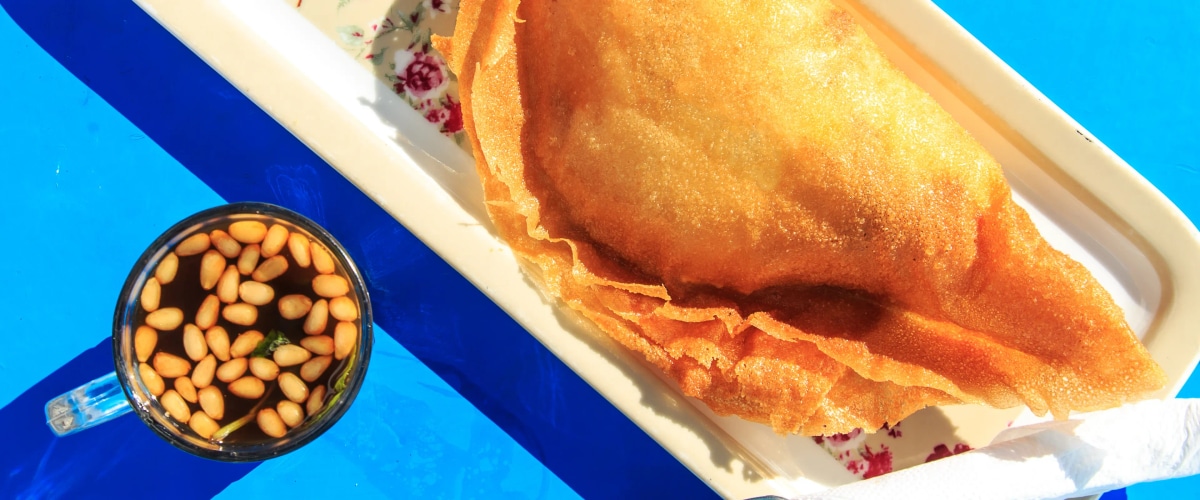
Adjaruli Khachapuri: The Cheesy Bread That’s the Cornerstone of Georgian Community
Soupy dumplings known as khinkali. Petite clay pots of stewed beans called lobio served with a medley of pickled jonjoli flowers and crispy mchadi cornbread. Badrijani nigvzit made of eggplant slivers smothered in a garlicky walnut paste. These are just a few of the culprits that make the country of Georgia a glutton’s delight. But it's khachapuri, a glorified stuffed cheese bread, that is the true cornerstone of Georgian cuisine.
In writing, khachapuri dates to about the 17th century, when an Italian missionary said the dish was the key component of any festivity or dinner table. In actuality, its origins are much harder to pin down. Some sources indicate khachapuri dates to the 12th-century Georgian Renaissance. Others suggest it has been eaten by Georgians for time immemorial. No matter its inception, khachapuri has earned its rightful place as the country's national dish.

A bread ingrained in Georgian culture
Khachapuri has many faces across Georgia. According to research conducted by the Gastronomic Association of Georgia, there are 47 varieties of the dish, each with its own unique preparation and ingredients. Regardless of region, khachapuri remains a staple on menus throughout the country and a centerpiece at supras (traditional feasts).
Lali Papashvily, a prominent Georgian food and beverage consultant, says, “To Georgians, khachapuri is much more than simply bread with filling. There is a strong emotional connection that conjures up memories of feasts with family and friends.”

Papashvily is currently on a mission to get khachapuri added to UNESCO’s Intangible Cultural Heritage List, where it would gain recognition alongside traditional Georgian winemaking. In recent years, she has teamed up with anthropologists and culinary researchers to document and preserve khachapuri traditions in their varied forms. While khachapuri varies from region to region, most menus stick to the trinity: Imeruli khachapuri, Megruli khachapuri, and Adjaruli khachapuri, from Imereti, Samegrelo, and Adjara, respectively.
Adjaruli khachapuri, with its boat shape and pool of gloopy cheese topped with a hunk of butter and golden egg yolk, is by far the most decadent of them all.
Best devoured en masse with loved ones, Adjaruli khachapuri is a communal dish with frequent appearances at casual dinners among friends, as well as supras—whose tables are spread with a cornucopia of other Georgian classics, like juicy mtsvadi (grilled skewers), creamy shkmeruli (baked chicken in a garlic and milk sauce), and ojakhuri (a fried pork and potatoes dish whose name literally means “family meal”). With its open pool of cheese meant for collective dipping, Adjaruli khachapuri is a symbol of togetherness.
Papashvily explains that “even the Georgian word for friend, megobari, is loosely broken down as someone to share a bowl with.” Etymologically, this “bowl” is figurative and not necessarily filled with cheese and butter. More importantly, it speaks to an intrinsic presence of shared food—of which Adjaruli khachapuri reigns supreme—in Georgian culture. (In fact, there’s a biblical Georgian tale in which God sat down with the locals for a supra. Having a splendid time, God gave the Georgian people the land he’d been saving for himself: a small stretch of paradise in the Caucasus Mountains wedged between Russia, Turkey, Armenia, and Azerbaijan.)
Khachapuri is such a signature dish, in fact, that economists at the International School of Economics (ISET) at Tbilisi State University created the Khachapuri Index to measure inflation by tracking the prices of its standard ingredients—flour, cheese, yeast, milk, eggs, and butter. Khachapuri even has its own holiday: Khachapuri Erovnuli Dghe (National Khachapuri Day) on February 27.

A dairy delight
Adjaruli khachapuri, often simply referred to as Adjaruli, hails from Georgia’s western region of Adjara, where lush, emerald mountains hug the turquoise shores of the Black Sea. You’d be forgiven for assuming the regional specialty is seafood; while there’s plenty of crispy red mullet to go around, the real star of the show is dairy, thanks to the region’s mild yet alpine climate and verdant pastures perfect for herding cattle year round. Adjarian dairy specialties include borano (a brown butter and salty cheese fondue of sorts), sinori (a dish of delicate flatbread pinwheels smothered in rich butter and curds), and kuruti (delectable sun-dried balls of sharp cheese). The crème de la crème, however, is Adjaruli khachapuri.
It starts with a slow-leavened dough that has been carefully shaped into an oval with shallow walls and knobs on either side. The hollow is traditionally filled with two cheeses that dominate Georgian cuisine—tangy imeruli and salty sulguni—and then baked. Once the dough becomes bread and the cheese a molten puddle, it’s time for the finishing touches: a bright orange egg yolk and a generous slab of butter.
The sooner you dig in, the better. But remember the two cardinal rules: no forks and no leftovers. Start by tearing off a knob and swirling the well together until the yolk, cheese, and butter are combined. Then use the piece of bread to scoop up a bite of the mixture. Repeat until you embody “shemomechama”—an untranslatable Georgian word for when you’re bursting-at-the-seams full but continue eating anyway.

Taste of sun and sea
With a few exceptions (such as Guruli khachapuri—a crescent-shaped, cheese-and-egg-filled bread from the region of the same name), khachapuri, by and large, is stuffed and saucer-shaped so the fillings are fully cooked within the bread. So what’s the deal with Adjaruli?
Tucked away on a quiet, hilly tangle of streets in Old Tbilisi’s Mtatsminda district is Gunda, Papashvily’s passion project, a first-of-its-kind artisan khachapuri bakery.
Inside the honey-hued bakery with mint accents and cream-colored dome awnings, the bakers are hard at work kneading dough made with ancient grains exclusively from Georgia’s Samtskhe-Javakheti region. It’s hard to miss the little note cards sitting on the counter with a colorful coastal scene on them: three men lassoing the sun from the sky and pulling it down to a cheesy bread boat floating on the sea.
The precise origin of Adjaruli khachapuri is not clear, but legend has it that the bread symbolizes the boats that bob across the Black Sea carrying the hard-working fisherman that support the community, while the yolk is the sun shining down. It’s a beautiful tale, but according to Papashvily, it’s more of a poetic parable.
She explains that, as she’s traced the footsteps of khachapuri, it’s led her “to many unique and forgotten recipes that have been lost to time.” As she and her team conducted their research, they determined that Adjaruli was likely created to be an amplified, cheesy cousin of pide—a Turkish flatbread with meats, cheeses, and other toppings. It’s thought that the Adjaruli version was heavily influenced by the Laz people, an ethnic group native to Georgia and Turkey’s Black Sea area. The anonymity of its precise origins doesn’t dampen its significance; on the contrary, Adjaruli is an edible representation of the diverse perspectives that have influenced Georgia’s table.
Where to eat Adjaruli khachapuri around Georgia
Gunda, Tbilisi
Run by Papashvily and her husband, Levan Qoqiashvili, Gunda is the country’s first artisan khachapuri bakery. They offer several regional variations of khachapuri and prioritize “grain-to-table” sustainability, and of course, keeping each khachapuri as authentic as possible.
Laguna, Batumi
A local favorite in Batumi, the capital of Adjara, Laguna is famous for its various types of Adjaruli, including smaller sizes perfect for a savory breakfast.
Arrive hungry—Retro is famous for whipping up Adjaruli so huge it needs five yolks on top. But if you’re not in the mood for a sedan-sized cheese boat, Retro also has standard sizes that taste just as good.
Read more about delicious dishes around the world:
Last updated August 29, 2024









